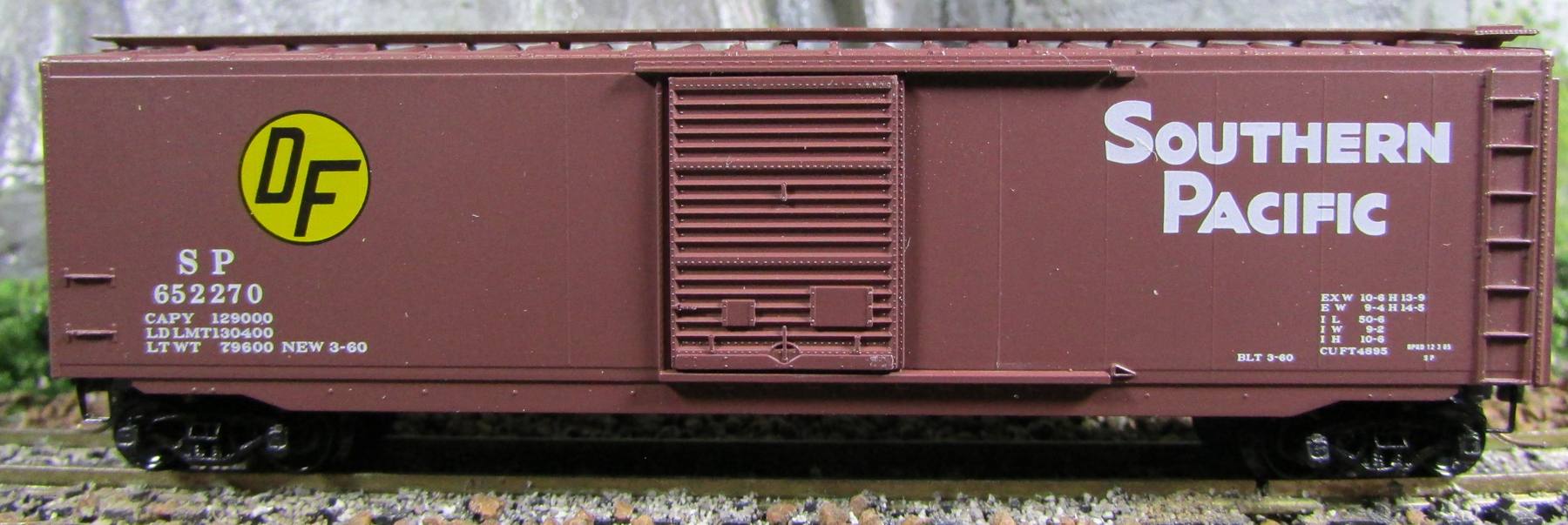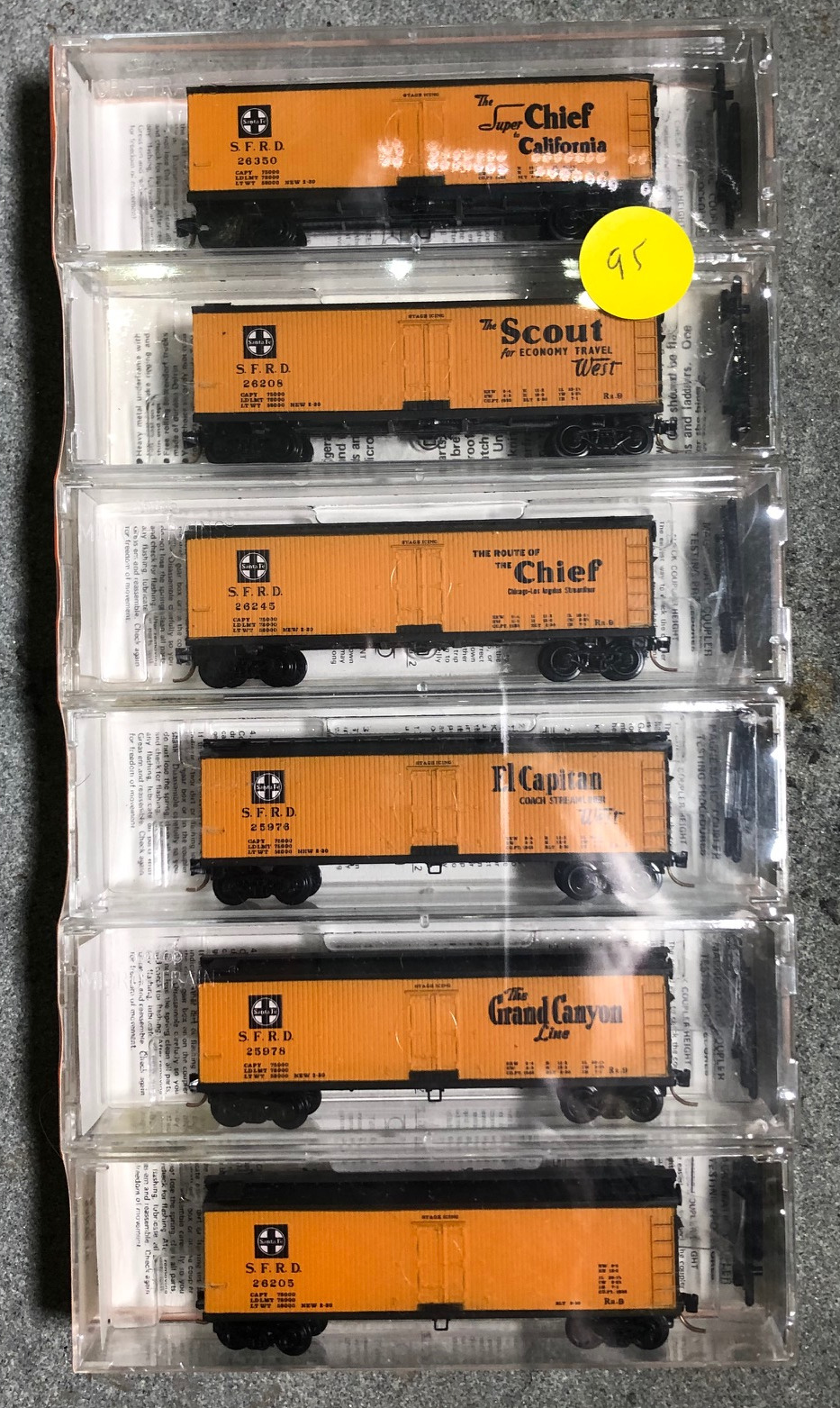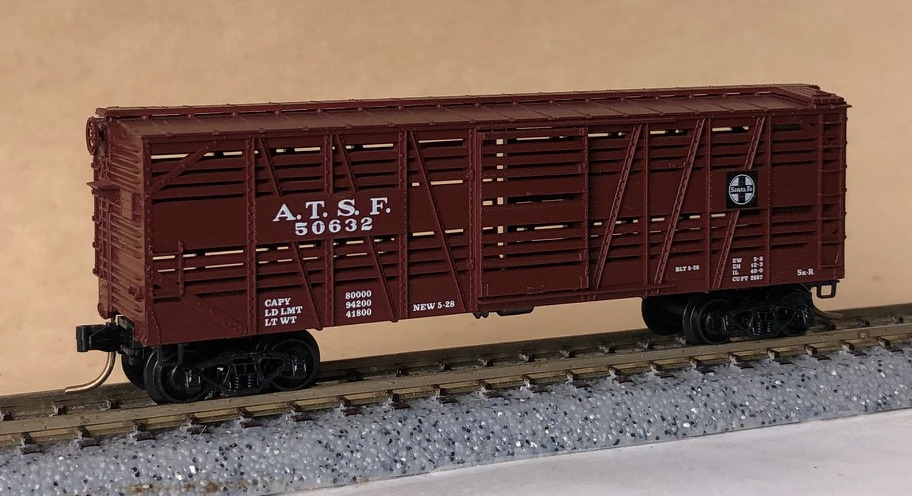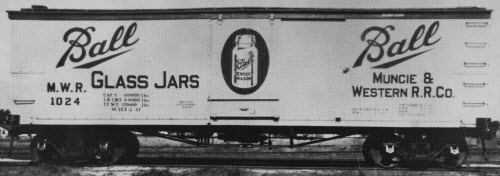Roundhouse - 8777 - Boxcar, 36 Foot, Wood Truss - Central Pacific - 1022
Click to see the details
history
| Stock Number | 8777 |
| Original Retail Price | $7.98 |
| Brand | Roundhouse |
| Manufacturer | MDC Roundhouse |
| Body Style | MDC Boxcar 36 Foot Wood Truss Rod |
| Prototype Vehicle | Boxcar, 36 Foot, Wood Truss (Details) |
| Road or Company Name | Central Pacific (Details) |
| Reporting Marks | CPRR |
| Road or Reporting Number | 1022 |
| Paint Color(s) | Boxcar Red |
| Print Color(s) | White |
| Coupler Type | Rapido Hook |
| Wheel Type | Injection Molded Plastic |
| Wheel Profile | Small Flange (Low Profile) |
| Release Date | 1998-06-01 |
| Item Category | Rolling Stock (Freight) |
| Model Type | Boxcar |
| Model Subtype | 36 Foot |
| Model Variety | Wood Truss Rod Underframe |
| Prototype Region | North America |
| Prototype Era | NA Era II: Late Steam (1901 - 1938) |
| Scale | 1/160 |
Specific Item Information:
Listed as new in the 1999 Walthers N&Z Reference Book
Model Information:
This MDC tooling models a pre-1900 boxcar with a truss-rod underframe. The MDC Truss-Rod underframe 36' Reefer and 36' Boxcar are very similar models. They were introduced in 1997 for the former and 1998 for the latter. The easiest way to tell the difference is that the reefers have plug doors and the boxcars have sliding doors. Like all of MDC N-Scale molds, this one was also acquired by Athearn in 2004 when they acquired MDC. The MDC releases were supplied in both 'kit' and RTR (Ready-To-Run) versions.
The Athearn (post 2004) releases come fully assembled and feature:
The Athearn (post 2004) releases come fully assembled and feature:
- Fully assembled and ready to operate
- Separately applied brake wheel and roof walk
- Molded truss rods with turnbuckles
- Molded plastic underframe with brake cylinder
- Screw mounted trucks for accurate tracking
- Truck mounted magnetically operated knuckle couplers
- Plastic wheels.
Prototype History:
Boxcars in the early 20th century frequently featured a "Truss-Rod" design. The purpose of truss rods was to prevent the railcars from sagging in the middle by the use of turnbuckles in the center of the truss rods for tightening. Due to the limitations of the materials available at the time, there was a tendency for the railcars body to sag in the middle, between the trucks. Truss rods were designed to prevent this. They have the same purpose as I beams or channel beams do in more modern equipment; or, the unitized body of automobiles do today. They give strength in the direction needed to support the load placed on the car.
Road Name History:
 The CP was established in 1861 by a group of California businessmen: Huntington, Hopkins, Crocker and Stanford. These men were given the collective name the Big Four (no relation to the Big Four route of the Cleveland Cincinnati Chicago & St. Louis Railroad.) CP was to build from Sacramento, California over the Sierra Nevada Mountains to Virginia City, Nevada. The following year, Congress expanded the mission of the CP to continue building east and meet the Union Pacific that would be building west to form the first transcontinental railroad. Construction began in 1863. They reached the Nevada state line in 1867 and in May of 1869 met the Union Pacific in Utah.
The CP was established in 1861 by a group of California businessmen: Huntington, Hopkins, Crocker and Stanford. These men were given the collective name the Big Four (no relation to the Big Four route of the Cleveland Cincinnati Chicago & St. Louis Railroad.) CP was to build from Sacramento, California over the Sierra Nevada Mountains to Virginia City, Nevada. The following year, Congress expanded the mission of the CP to continue building east and meet the Union Pacific that would be building west to form the first transcontinental railroad. Construction began in 1863. They reached the Nevada state line in 1867 and in May of 1869 met the Union Pacific in Utah.
With the golden spike driven, CP turned west. They established a subsidiary called Western Pacific (unrelated to the Western Pacific that would later build from the Bay Area to Utah) and acquire the California Pacific to reach the San Francisco Bay at Vallejo. In 1879, CP built from Port Costa to Oakland (trains were barged from Vallejo to Port Costa until Carquinez Strait was finally bridged in 1929.) By 1870, the Big Four had gained control of the Southern Pacific and other area lines. Construction to the south was divided with some segments belonging to Southern Pacific and others to Central Pacific. The CP got as far south as Goshen Junction, about 50 miles south of Fresno.
Also in 1870, the CP bought the California & Oregon Railroad that was building north from Marysville, California. This line was pushed north through the Siskiyou Mountains to a connection with the Oregon & California Railroad at Ashland, Oregon. The Southern Pacific then bought the O&C. By 1884, the operational boundaries between Central Pacific and Southern Pacific were blurred. That year, the companies were re-organized and Central Pacific’s railroad was leased to Southern Pacific. SP continued to add to the CP network. The last of the Big Four died in 1900 and control of the SP and CP was acquired by E.H. Harriman. The last additions to the CP system were the Natron Cutoff and the Modoc Line, both built in the 1920s. It was common during this period for CP equipment to be lettered Southern Pacific and even carry SP reporting marks but have either a small C.P. or even CENTRAL PACIFIC lettering (3” or smaller in a corner of the car side.) Following the breakup of the Harriman empire, Southern Pacific fought to hold on to the Central Pacific. The two were so entangled in their routes down the Central Valley and north into Oregon that splitting them would have been unworkable. Central Pacific remained a paper railroad under the Southern Pacific flag until finally merged out of existence in 1959.
Thanks to Craig Ross of Bluford Shops for this history.

With the golden spike driven, CP turned west. They established a subsidiary called Western Pacific (unrelated to the Western Pacific that would later build from the Bay Area to Utah) and acquire the California Pacific to reach the San Francisco Bay at Vallejo. In 1879, CP built from Port Costa to Oakland (trains were barged from Vallejo to Port Costa until Carquinez Strait was finally bridged in 1929.) By 1870, the Big Four had gained control of the Southern Pacific and other area lines. Construction to the south was divided with some segments belonging to Southern Pacific and others to Central Pacific. The CP got as far south as Goshen Junction, about 50 miles south of Fresno.
Also in 1870, the CP bought the California & Oregon Railroad that was building north from Marysville, California. This line was pushed north through the Siskiyou Mountains to a connection with the Oregon & California Railroad at Ashland, Oregon. The Southern Pacific then bought the O&C. By 1884, the operational boundaries between Central Pacific and Southern Pacific were blurred. That year, the companies were re-organized and Central Pacific’s railroad was leased to Southern Pacific. SP continued to add to the CP network. The last of the Big Four died in 1900 and control of the SP and CP was acquired by E.H. Harriman. The last additions to the CP system were the Natron Cutoff and the Modoc Line, both built in the 1920s. It was common during this period for CP equipment to be lettered Southern Pacific and even carry SP reporting marks but have either a small C.P. or even CENTRAL PACIFIC lettering (3” or smaller in a corner of the car side.) Following the breakup of the Harriman empire, Southern Pacific fought to hold on to the Central Pacific. The two were so entangled in their routes down the Central Valley and north into Oregon that splitting them would have been unworkable. Central Pacific remained a paper railroad under the Southern Pacific flag until finally merged out of existence in 1959.
Thanks to Craig Ross of Bluford Shops for this history.
Brand/Importer Information:
 MDC Roundhouse was founded in California in 1938 and relocated in 1993 to Carson City, Nevada due to statewide restrictions on painting. MDC Roundhouse was a producer of both RTR (Ready-to-Run) and kit versions of N Scale rolling stock as well as RTR locomotives. They entered the N scale market in 1979 with a Thrall Hi-Side Gondola and a Hi-Cube Single Door Box Car. MDC Roundhouse was purchased by Horizon Hobbies in June of 2004, when its owner since 1938 C. H. Menteer retired, and merged into their Athearn line.
MDC Roundhouse was founded in California in 1938 and relocated in 1993 to Carson City, Nevada due to statewide restrictions on painting. MDC Roundhouse was a producer of both RTR (Ready-to-Run) and kit versions of N Scale rolling stock as well as RTR locomotives. They entered the N scale market in 1979 with a Thrall Hi-Side Gondola and a Hi-Cube Single Door Box Car. MDC Roundhouse was purchased by Horizon Hobbies in June of 2004, when its owner since 1938 C. H. Menteer retired, and merged into their Athearn line.
Unlike many of their contemporaries which contracted with European firms to produce their products, MDC made their own toolings. They made several popular body styles and produced them for road names that many other vendors (even Micro-Trains) wouldn't touch. This made them popular with modelers. Also, their un-assembled "kits" permitted a lower price point so they were popular with "runners" as well as "modelers".
Of particular interest was the attention given to modern 50 foot steel boxcars. They made some attempt to accurately mold the differences into distinct models to represent each of the major prototype manufacturers products. They have distinct toolings not only for the different products from FMC, BFF and PS, but also multiple models for each of these manufacturers including "standard" vs "Youngstown" doors and "waffle" vs. "rib" sides. In total they produced 13 different versions of the 50 foot steel boxcar.

Unlike many of their contemporaries which contracted with European firms to produce their products, MDC made their own toolings. They made several popular body styles and produced them for road names that many other vendors (even Micro-Trains) wouldn't touch. This made them popular with modelers. Also, their un-assembled "kits" permitted a lower price point so they were popular with "runners" as well as "modelers".
Of particular interest was the attention given to modern 50 foot steel boxcars. They made some attempt to accurately mold the differences into distinct models to represent each of the major prototype manufacturers products. They have distinct toolings not only for the different products from FMC, BFF and PS, but also multiple models for each of these manufacturers including "standard" vs "Youngstown" doors and "waffle" vs. "rib" sides. In total they produced 13 different versions of the 50 foot steel boxcar.
Item created by: gdm
on 2017-12-06 08:27:25
Last edited by: meadowsn1956 on 2021-01-11 20:18:00
If you see errors or missing data in this entry, please feel free to log in and edit it. Anyone with a Gmail account can log in instantly.
Last edited by: meadowsn1956 on 2021-01-11 20:18:00
If you see errors or missing data in this entry, please feel free to log in and edit it. Anyone with a Gmail account can log in instantly.









